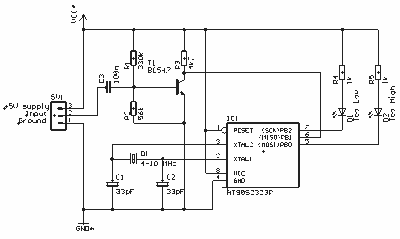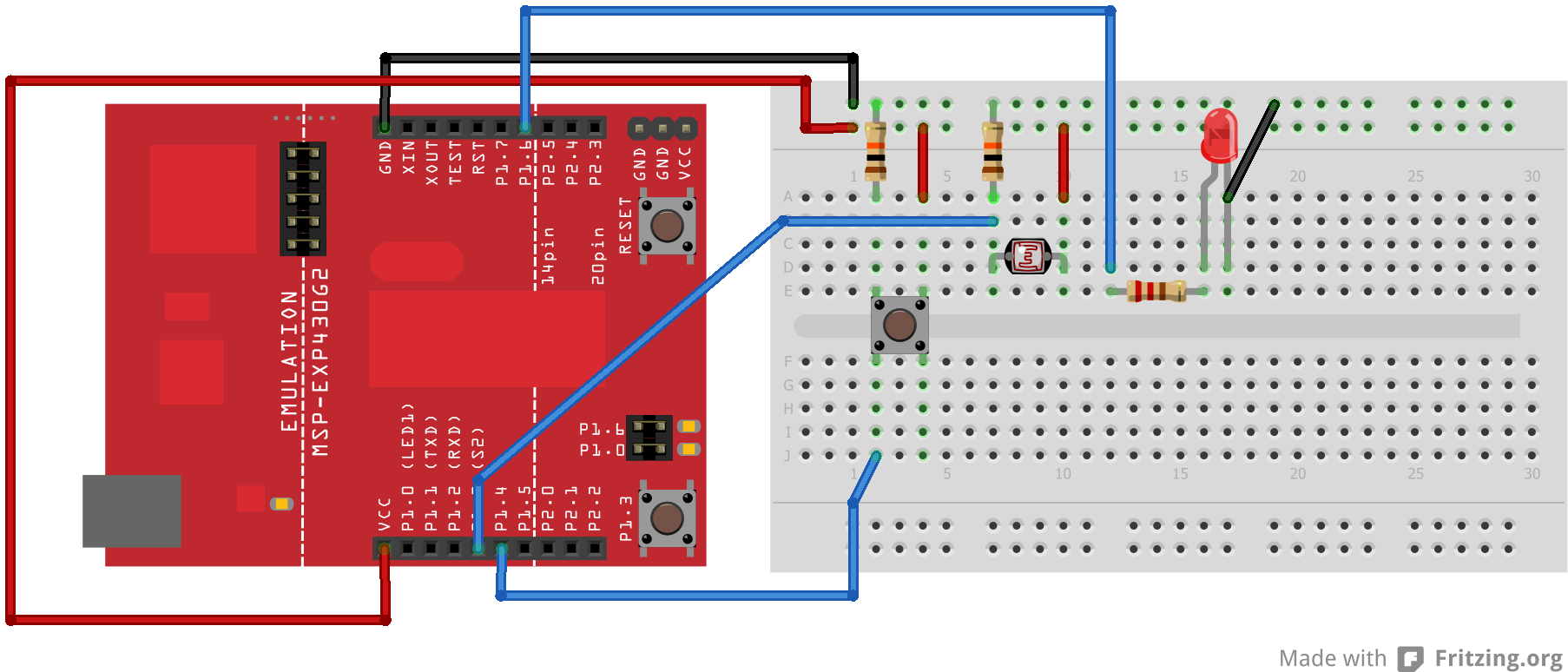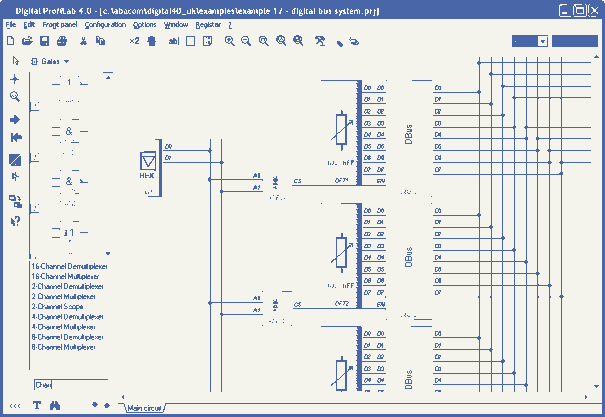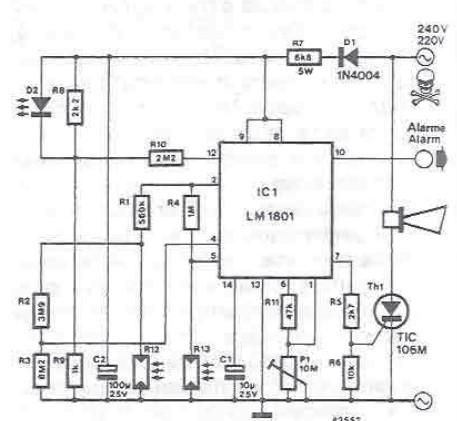
Digital Combination LockCircuit Project Tutorial
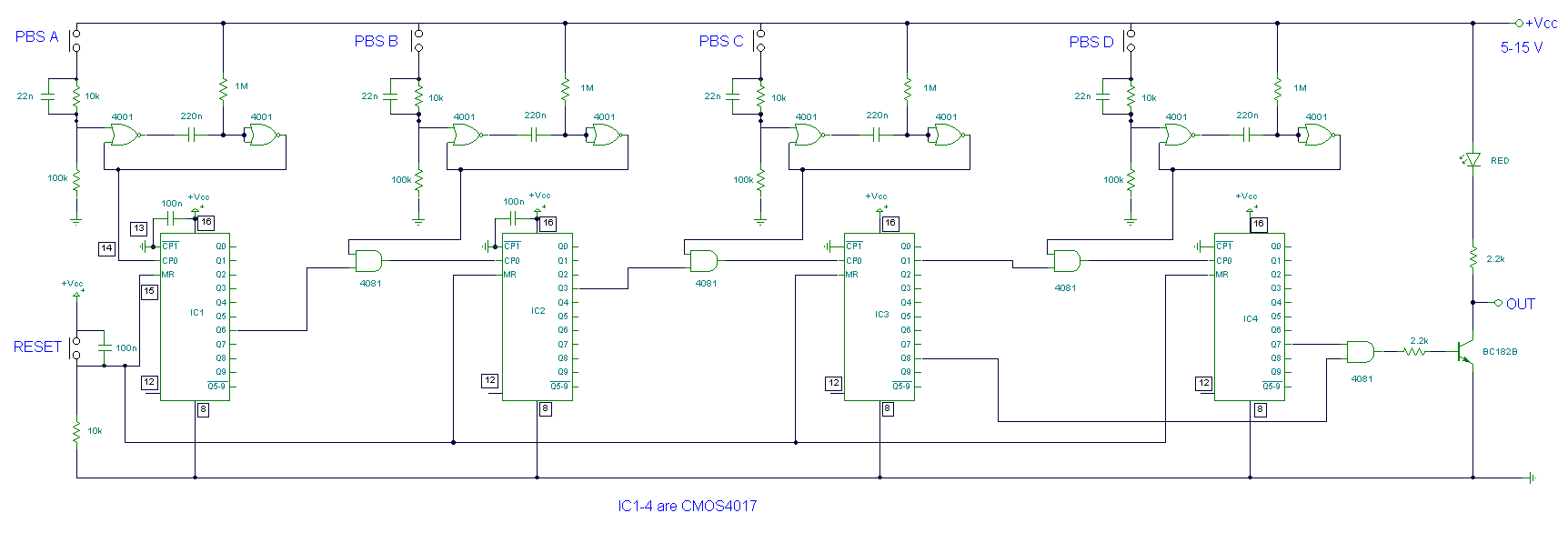
The circuit utilizes the CMOS 4017 decade counter integrated circuit (IC). Each press of a switch advances the output from 0 to 9. By connecting the output through an AND gate to the subsequent IC, a specific code must be entered to generate the output. Each push button switch (PBS) is debounced using two gates from a CMOS 4001 quad 2-input NOR gate, ensuring a clean pulse is sent to the input of each CMOS 4017 counter. Only after the correct number of presses at PBS A will PBS B become active. This process is similarly applied to PBS C and PBS D. At IC4, PBS D must be pressed 7 times, followed by PBS C being pressed 7 times, which advances the output from 1 to 8. The AND gate constructed using CMOS 4081 then activates, illuminating the LED. The reset switch can be engaged at any time, and a power-on reset is facilitated by the 100nF capacitor positioned near the reset switch.
The circuit design features a sequential operation utilizing the CMOS 4017 decade counter, which is designed to count from 0 to 9, with each output pin corresponding to a specific count. The output from the 4017 is connected to an AND gate formed by the CMOS 4081, which requires a specific sequence of button presses to activate the LED indicator.
The debouncing mechanism is critical in this circuit as it ensures that each button press is registered as a single event, preventing multiple counts from a single press due to mechanical bounce. The use of two NOR gates from the CMOS 4001 for each switch effectively filters out noise and provides a clean signal to the counter.
The operation begins with PBS A; only after the correct number of presses is detected will the subsequent PBS B become active. This cascading requirement continues through PBS C and PBS D, creating a multi-step input sequence that must be adhered to in order to activate the output. Specifically, PBS D requires seven presses, followed by PBS C also requiring seven presses, which transitions the output state from 1 to 8.
The AND gate's output is directly linked to an LED, providing a visual indication of successful code entry. The reset functionality is included to allow the user to reset the circuit at any point, ensuring flexibility in operation. The power-on reset feature, enabled by the 100nF capacitor, ensures that the circuit starts in a known state when powered on, preventing any unintended behavior due to residual charge in the circuit components.
Overall, this circuit exemplifies a practical application of digital logic and counting mechanisms, showcasing how various components can interact to create a user-defined output based on a specific input sequence.The circuit above makes use of the CMOS 4017 decade counter IC. Each depression of a switch steps the output through 0 - 9. By coupling the output via an AND gate to the next IC, a predefined code has to be input to create the output. Each PBS switch is debounced by two gates of a CMOS4001 quad 2-input NOR gate. This ensures a clean pulse to the i nput of each CMOS 4017 counter. Only when the correct number of presses at PBS A will allow PBS B to become active. This is similar for PBS C and PBS D. At IC4, PBS D must be pressed 7 times. Then PBS C is again pressed 7 times, stepping from output 1 to output 8. The AND gate formed around CMOS4081 then goes high, lighting the LED. The Reset switch can be pressed at any time. Power on reset is provided by the 100n capacitor near the reset switch. 🔗 External reference
The circuit design features a sequential operation utilizing the CMOS 4017 decade counter, which is designed to count from 0 to 9, with each output pin corresponding to a specific count. The output from the 4017 is connected to an AND gate formed by the CMOS 4081, which requires a specific sequence of button presses to activate the LED indicator.
The debouncing mechanism is critical in this circuit as it ensures that each button press is registered as a single event, preventing multiple counts from a single press due to mechanical bounce. The use of two NOR gates from the CMOS 4001 for each switch effectively filters out noise and provides a clean signal to the counter.
The operation begins with PBS A; only after the correct number of presses is detected will the subsequent PBS B become active. This cascading requirement continues through PBS C and PBS D, creating a multi-step input sequence that must be adhered to in order to activate the output. Specifically, PBS D requires seven presses, followed by PBS C also requiring seven presses, which transitions the output state from 1 to 8.
The AND gate's output is directly linked to an LED, providing a visual indication of successful code entry. The reset functionality is included to allow the user to reset the circuit at any point, ensuring flexibility in operation. The power-on reset feature, enabled by the 100nF capacitor, ensures that the circuit starts in a known state when powered on, preventing any unintended behavior due to residual charge in the circuit components.
Overall, this circuit exemplifies a practical application of digital logic and counting mechanisms, showcasing how various components can interact to create a user-defined output based on a specific input sequence.The circuit above makes use of the CMOS 4017 decade counter IC. Each depression of a switch steps the output through 0 - 9. By coupling the output via an AND gate to the next IC, a predefined code has to be input to create the output. Each PBS switch is debounced by two gates of a CMOS4001 quad 2-input NOR gate. This ensures a clean pulse to the i nput of each CMOS 4017 counter. Only when the correct number of presses at PBS A will allow PBS B to become active. This is similar for PBS C and PBS D. At IC4, PBS D must be pressed 7 times. Then PBS C is again pressed 7 times, stepping from output 1 to output 8. The AND gate formed around CMOS4081 then goes high, lighting the LED. The Reset switch can be pressed at any time. Power on reset is provided by the 100n capacitor near the reset switch. 🔗 External reference

